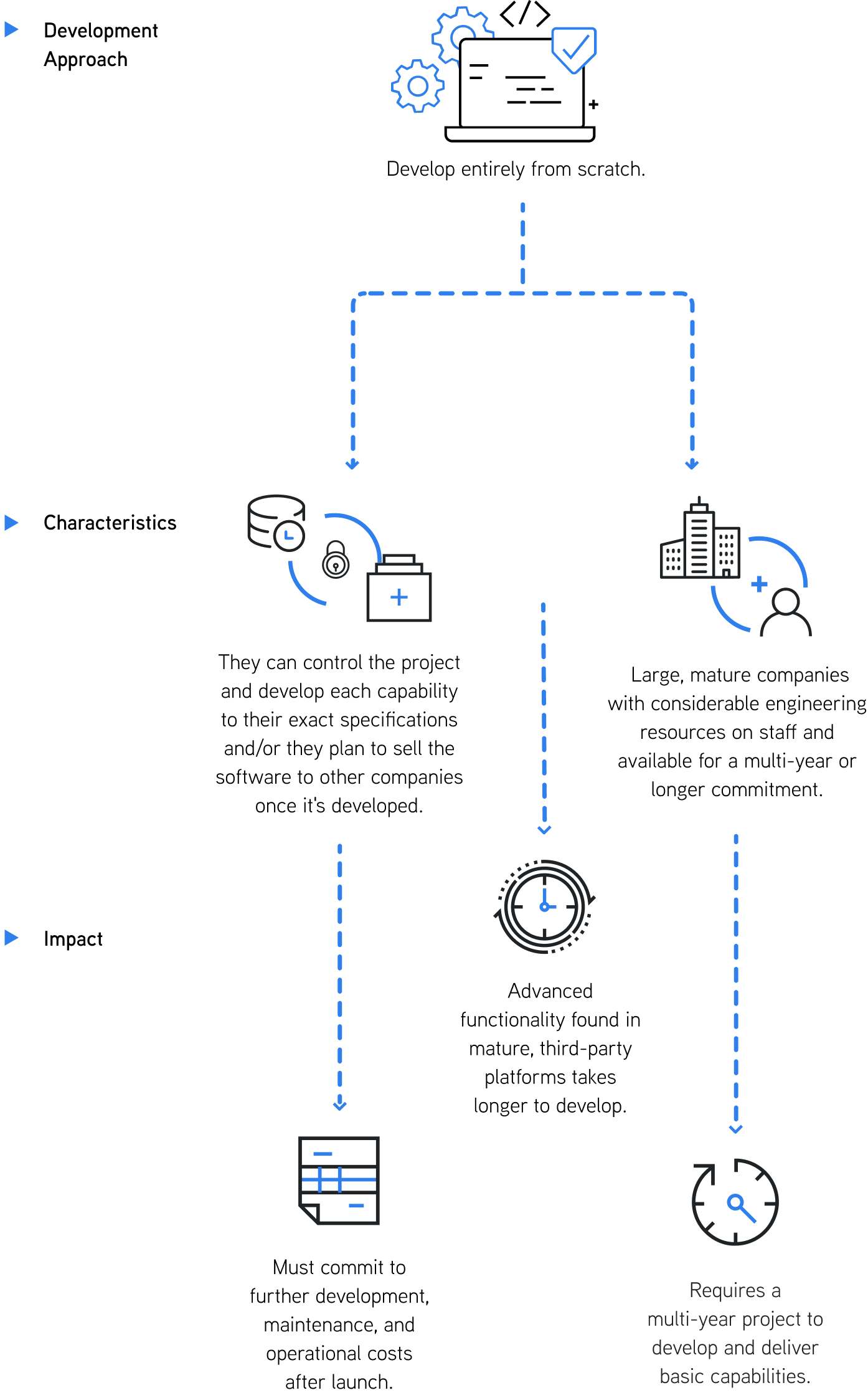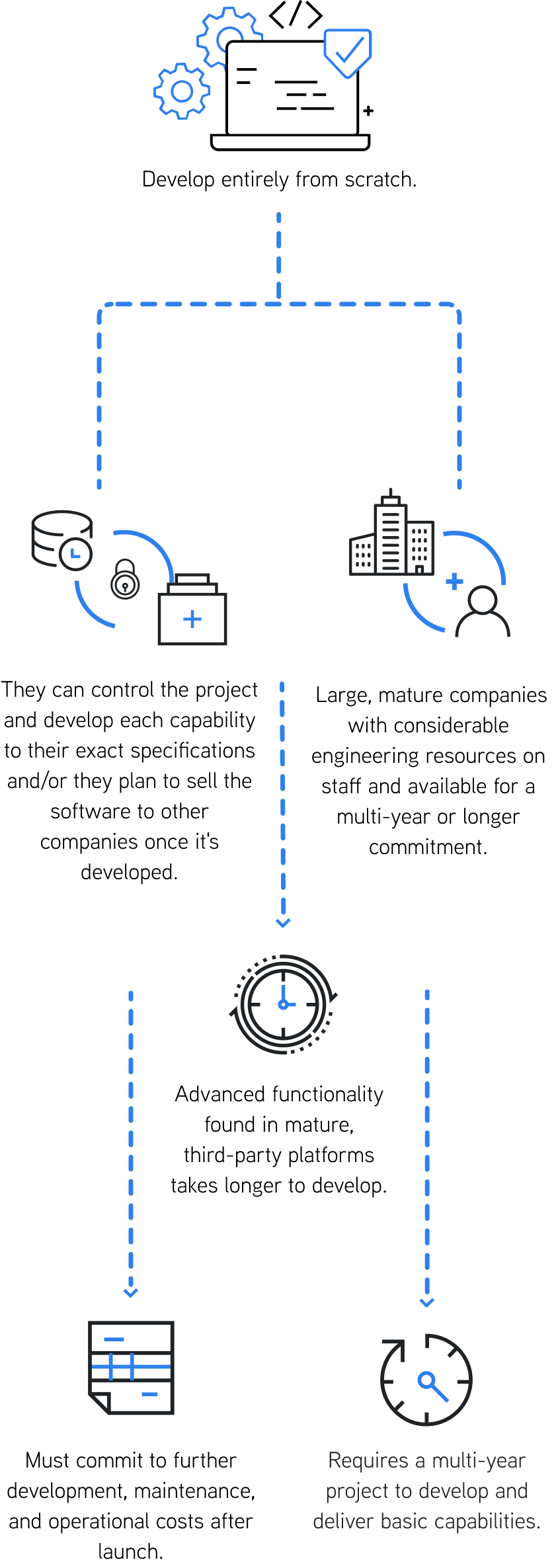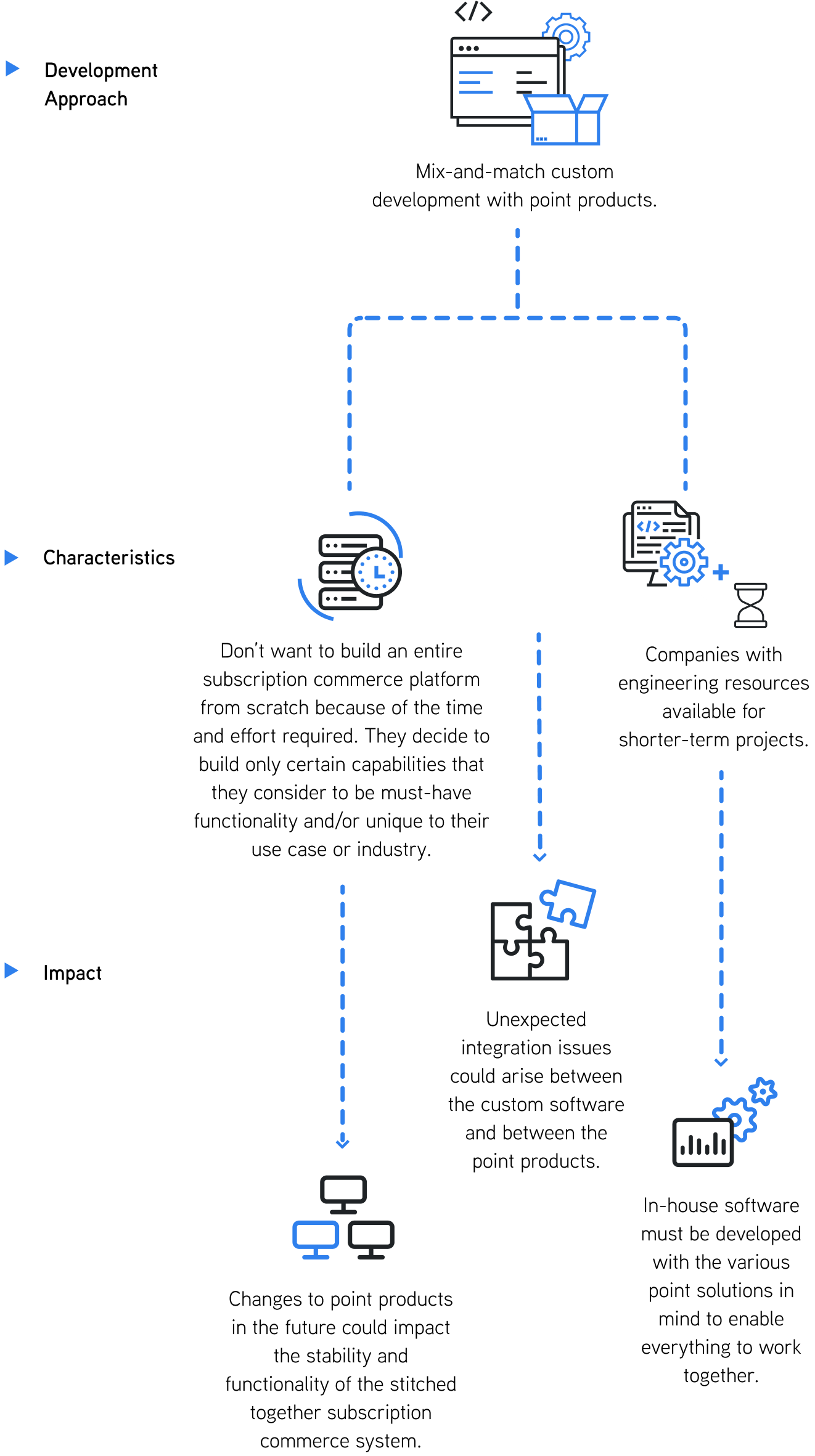Consider the Pros and Cons Before you Decide
Companies that adopt a B2B subscription commerce model stand to gain more than just the recurring revenue.
Investors reward companies with recurring revenue models with far higher valuations than those with only traditional, one-time transaction models. Beyond growing revenue and valuation, many companies pivot to subscription commerce to differentiate their brand, improve customer loyalty and share of wallet, and reduce their cost of sale, among other reasons.
But a subscription commerce model itself doesn’t guarantee success. A make-or-break factor that you must consider is your platform. How will your company go about getting the capabilities required—from the digital marketplace to provisioning, to onboarding, to billing, customer relationship management, and beyond—in place as quickly and as cost-effectively as possible?
The decision to build or buy the platform and capabilities you need to support subscription commerce can have a major impact on your go-to-market strategy. Should you build the capabilities you need for your subscription commerce model in-house or should you choose an off-the-shelf platform? Or is it better to buy multiple point solutions and write custom code to fill in the gaps in functionality?
Over the past decade, we’ve helped many companies deploy the capabilities they need to be successful with subscription commerce. The following considerations and pros and cons can help inform your business case and help you decide how to move forward.
This chapter covers:
- Core capabilities your company will need for either a build or buy scenario
- The pros and cons of each approach
- How to evaluate your options and make a decision
Understanding the Core Capabilities Your Company Will Need
By now, you’re probably aware that the subscription commerce model is very different and significantly more complex than one-time transactions. To deliver a frictionless find, buy, and manage experience for customers, streamline your operational processes, and enable you to grow and manage an ecosystem around your offering, you’ll need technology designed for subscription commerce.
That technology needs to support multi-vendor, multi-service, multi-channel, and multi-device subscription commerce by delivering the following capabilities, at a minimum:
Customer Relationship Management
Marketplace Commerce
Onboarding
Billing
Identity & Access Management
Spend Management
Data Analytics & Reporting
APIs to Integrate with Existing Business Systems
Approaching the Development Project on Your Own
Some companies start their subscription commerce journeys assuming they will build supporting capabilities and technologies in-house rather than purchasing an off-the-shelf solution. Here are some of the common reasons companies consider building a subscription commerce platform themselves.
Common Reasons for Choosing to Build From Scratch
FIT/CONTROL
When certain aspects of a company’s use case do not appear to align 100 percent with off-the-shelf software, some organizations decide it’s better to develop the capabilities they need on their own. This gives them complete control over fit and function.
PHILOSOPHY
Companies known for developing their own innovative technology are often hesitant to use off-the-shelf software on principle, even if the capabilities to be developed are not core to the company’s business.
COST
When companies already have a large developer organization on staff, cost savings is often seen as a driver for developing even non-core software in-house.
PERCEPTION
Based on assumptions made about the use case or a lack of understanding of the requirements for subscription commerce, some companies aren’t aware that a suitable, off-the-shelf platform solution exists. The belief is that building it themselves is the only option because no existing, third-party software will meet their needs.
In the Build-It-Yourself Scenario, Companies Typically Choose One of Two Approaches:
Developing all capabilities from scratch


Developing some capabilities from scratch and buying others off the shelf in a mix-and-match fashion.


Download the AppDirect
Definitive Guide to Subscription Commerce
By submitting this form, you confirm you have read our privacy notice and agree to the terms of service.
Weighing the Pros and Cons
To determine the fastest, lowest-risk, and most cost-effective way to adopt subscription commerce, start by considering all the pros and cons of building the supporting technology yourself buying/subscribing to the technology from a third-party provider. Identify how the pros and cons apply to your organization and your company strategy.
Build It Yourself (The Entire Platform or Mix-and-Match)
Pros
Control of the entire project, from design and user experience to technology stack used (except for mix-and-match scenarios where point solutions limit choices)
Built from the ground up for the exact features and requirements you want (again, except for mix-and-match scenarios where some compromises will be required)
Cons
Slower time to market
Lack of in-house skills and knowledge around building and scaling a subscription commerce platform
Cost of engineering and product management resources for planning, development, and testing
Cost of infrastructure and operations
Opportunity cost of engineering resources not working on innovation for the core business
For mix-and-match scenarios, unplanned/unexpected issues with integrating point solutions to meet requirements
Buying/Subscribing to a Third-Party SaaS Platform
Pros
Faster time to market
Reduced project risk
In-house resources can focus on core business innovation
Continuous updates and capabilities per roadmap
Fully hosted and managed service
Total cost of ownership is predictable
Cons
Standardized platform and features for which some project requirements might have to be modified to fit
Companies can influence the roadmap, but not control it
Building the Business Case
To prevent the build-versus-buy decision from delaying or derailing your go-to-market plans for subscription commerce, involve key stakeholders early as you begin building your business case and defining your strategy for subscription commerce.
Key stakeholders usually include IT, finance, product management, and others as appropriate to your industry and business.
To inform your business case, develop a financial model that shows costs and return on investment of the options you’re considering. This model doesn’t have to be overly complex, but it should be forward-looking over a period of five years so that you can accurately reflect the value to your business of getting to market sooner rather than later.
Finally, ask yourself these questions and make sure you’re reflecting the answers in the financial model, business case, and decision-making process:
- Is building a subscription commerce platform part of my core business?
- Do we plan to sell this platform to other companies (i.e., will a custom-developed platform generate revenue for the business?)
- If building it ourselves delays our launch, how far behind our competitors will we be?
- How will a delay to market impact our ability to grow market share and revenue?
- What is the value over time of getting to market faster (revenue and company valuation over a five-year plan)?
Creating a Platform and Vendor Checklist
While some companies will conclude that building the capabilities they need in-house is the right decision for their business strategy and needs, most will instead choose to deploy an off-the-shelf subscription commerce platform. For those who have decided to work with a provider, the next step is to develop a requirements list for both the technology and the vendor providing it.
Here are some important criteria to include on your checklist:
Platform Requirements
- Ease of integration with your existing technology stack
- Open and agnostic to help you future proof your strategy
- Frequent releases and continuous platform evolution
- Scalability
Vendor Requirements
- Global expertise and experience to help you reduce risk and accelerate time to market
- Strong references from other companies in your industry
- Professional services to complement and extend your in-house expertise and resources
- Strong security and governance measures to help you comply with relevant mandates
“It didn’t make sense to build a marketplace on our own with all the bells and whistles we needed. We wanted a partner that is a leader in the space and one that would be open to customizations for our agent-driven approach.”
“It didn’t make sense to build a marketplace on our own with all the bells and whistles we needed. We wanted a partner that is a leader in the space and one that would be open to customizations for our agent-driven approach.”
Chapter 5
Key Takeaway:
The decision to build or buy the platform and capabilities you need to support subscription commerce can have a major impact on your go-to-market strategy.
Getting to market quickly with a new subscription commerce offering can mean the difference between gaining an early mover advantage or lagging the competition.
Choosing the fastest, lowest-risk, and most cost-effective way to adopt subscription commerce is a critical success factor for companies pivoting to a recurring revenue model.
Up Next